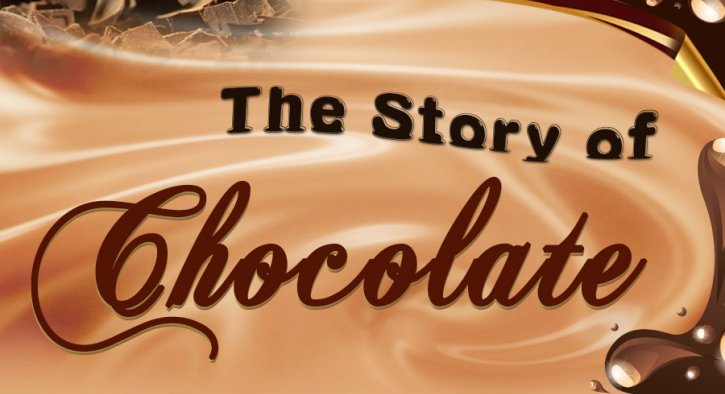Tag Archive: aztecs

The Story of Chocolate – Infographic
October 17, 2014
Chocolate has fascinated people all over the world for thousands of years. Today, forty to fifty million people depend on cocoa for their livelihoods. Here's an interesting infographic with more details.
Mexico To Charge Extra Tax On Chocolate
November 22, 2013
If the ancient Aztecs were around, they would not have approved. In the land where it all started, Mexican lawmakers have declared chocolate to be "junk," subject to an extra tax.
This specific charge is included in an array of fiscal changes passed by Mexico's Congress that are looking to expand tax revenues. It’s also an attempt to alter the country's unhealthy eating habits.
Included in the amendments added to the tax bill was a levy on "junk food". Products that contain higher than 275 calories per 100 grams belong in this group. Myriads of chocolate have about twice that amount. Originally proposed as a 5% levy, Congress approved an 8% charge on the foods. Other food items categorized as junk food include gelatin, sweets and some puddings.
Chocolates, Drugs Of The Past
July 19, 2012
Do not let the "drug" word fool you because there is actually more to that than meets the eye. In our current society, we often use drug to refer to illegal chemicals that will cause you a lot of jail time. However, the kind of drug we are about to discuss entails not only benefits to the body but also sweetness to the taste buds from then until now.
Dating back to the days when Mayans, Aztecs, and Early Europeans roamed the earth, chocolates were already within their midst. As opposed to the many variety of chocolates we have nowadays, the most popular for these earlier civilizations was chocolate in the form of a drink.
For the Aztecs, the cacao beans were brewed and drank in the belief that it was an elixir of life. It strengthened their warriors, cured the sick and awakened those who were weak and asleep.
Read more
Valentine’s Day Chocolate
February 14, 2012
Valentine's Day is many things to different people. It can be a shot at new beginnings, rekindling old flames, or a chance to show your special someone how you feel about them. To others, it can be a cold splash of reminder that they are alone on a supposedly lovey-dovey day. No matter what your expectations and reservations about Valentine's Day are, you cannot deny the fact that chocolate is a staple during Valentine's Day.
From the time of the Aztecs, chocolate has always been an effective gift. For a reason not fully known to man, it is, by some means, a magical way to say "I love you." Chocolate is a lot more than just food. A quote from Patrick Skene Catling, the author of the children's book entitled The Chocolate Touch, even says "Other things are just food. But chocolate's chocolate." True enough, even the scientific name of the tree which chocolate has been derived from, Theobroma cacao, translated from Greek, means "food of the gods."
Read more
Authentic Mexican Hot Chocolate
February 2, 2012
Chocolate, a native to Mexico, has been a staple there for centuries already. Initially, they enjoyed chocolate as a drink. They made variations og chocolate by incorporating different flavors and ingredients such as honey, spices, and nuts, among many others. The chocolate beverages they made did not have a sweet taste to them. Nevertheless, it was well-loved by the Aztec and Mayan royalty.
The Aztecs were whipping up and enjoying their hot chocolate drinks when the Spaniards arrived. They took the cacao beans along with them as they headed home, and started enhancing the flavors by adding milk and sugar. You can trace the roots of the hot chocolate drink recipe back to that. Shortly thereafter, chocolate became all the rage in European royal places. Special china pots and cups were produced, intended only for drinking hot chocolate. Nowadays, such kitchenware are considered as collectors’ items and can sell for a fortune if they come in a complete set.
Read more
The Guardian of Chocolate?
November 10, 2011
If you already have gone through the previous blog posts, you may have learned that chocolate can trace its origins back to the Aztecs. They have associated cacao trees with the god of agriculture, Quetzalcoatl. Legend has it that Quetzalcoatl was held responsible for bringing cacao to earth. His actions were frowned upon so he got kicked out of the heavens for giving it to humans. As he escaped, he swore to return one day as a “fair-skinned bearded man” to save the earth.
The earliest Aztecs highly thought of the cacao plant. They considered it as a source of strength and wealth and Quetzalcoatl was said to be its guardian which explains why cacao beans were used as their form of currency.
The Aztecs were among the first ones to work with cacao beans. However, they initially didn’t use this for any culinary purpose whatsoever. They only developed interest in its edibility after observing certain animals, particularly monkeys. This is why only the pulp of the cacao tree was used at first, only after a while did they start utilizing the beans.
Read more
Day of the Dead
October 6, 2011
Did you know that in Mexico, chocolate is used to make offerings during the Day of the Dead festival? This particular fiesta acts as a commemoration to pay tribute and honor all the deceased members of the family. Chocolate and sweets are important components of the festival. People give each other skulls made of chocolate or sugar. The Day of the Dead fete is celebrated throughout the country on the 1st and 2nd of November.
As morose as it may sound, it is in fact a cheerful occasion where departed loved ones are reminisced. Some families even construct altars dedicated to the dead relatives. The altars are filled with flowers, candles, wooden skulls and photos of the dead. The families celebrate and bring to mind the deceased members by eating the favorite foods of those passed. The specific foods that are specially eaten in this celebration are pan de muerto which is a skull-shaped bread and Calabaza en Tacha which is a dessert made with sweet pumpkin, cinnamon, and piloncillo, dark sugar cones.
Read more
The Beginning of Chocolate
August 25, 2011
Chocolate has been around for millennia now, and the history is extremely long and diverse. The earliest references of chocolate were over fifteen hundred years ago in the Central American Rain Forest, an ideal environment for the cultivation of the Cacao Tree because of the mix of high rain fall, temperature and humidity.
The Mayan culture worshiped the Cacao tree as they believed it was of divine origin and it symbolized life and fertility. Cacao is actually a Mayan word which meant “God Food”, modernly coined as “Food of the Gods”. The Mayans were believed to be brewing and drinking this spicy bittersweet beverage by roasting, grinding and fermenting the seeds of the Cacao Tree. This was intended for the wealthy and elite.
The Aztecs, like Mayans, also have their own version of the fermented drink and they called it Xocolatl, meaning “bitter water”. Their Emperor, Montezuma, allegedly believed that this was an aphrodisiac, and drank almost 50 cups a day. The beans were even used as currency and considered as treasure that when Spaniards came and searched for gold and silver, they found no more than the beans.
Read more
Fact or Fiction: Chocolate as Aphrodisiac
October 28, 2010
 Is chocolate an aphrodisiac? Everything I’ve read about cacao says that chocolate as an aphrodisiac is a myth.
Is chocolate an aphrodisiac? Everything I’ve read about cacao says that chocolate as an aphrodisiac is a myth.
Well, not everything I read says that, just the scientific stuff...
Read more
Chocolate as a Cure For Everything
November 3, 2009
Before modern science began discovering the much talked about health benefits of chocolate, the Mayans (central America) and Aztecs (ancient Mexico) considered it a powerful remedy to many ailments.
Theobroma cacao, or the “chocolate tree,” has been used in folk medicine as an anticeptic, diurectic, and parasiticide. It has been used to heal burns, cough, dry lips, fever, listlessness, malaria, nephrosis, rheumatism, snakebites, and small wounds.
Read more

